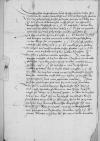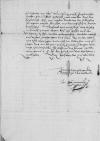Dem durchlauchten, hochgebornen fursten unnd herren, hern ⌊Albrechten⌋, von Gots gnaden marggraff zu ⌊Brandenburg⌋, in ⌊Preussen⌋, / zu ⌊Stettin⌋, ⌊Pomern⌋, / der ⌊Cassuben⌋ und ⌊Wenden⌋ hertzogk, burggraff zu ⌊Normberg⌋ und furst zu ⌊Rugen⌋, / unserm hochgunstigen, lieben hern und freunde /
Durchlauchter, hochgeborner furst, hochgunstiger, lieber herr und freundt. / Unsere freuntliche und vleiswillige dinste zuvoran. /
Wie wir 1540-10-11⌊gestrigs tags1540-10-11⌋ hie her gelanget, / hab wir mit vleis, / dorzu uns zuvor bekueme zeit nicht gewest, / die henndel koniglicher botschafft an Ewer Furstliche Durchlaucht uberlesen. / Bedancken uns auch hochlich, / das uns solchs Ewer Furstliche Durchlaucht hat mitgeteilt, / woraus wir uns viler dinge mussen wundern etc. Es hat auch der erbar, erntfest Ewer Furstlichen Durchlaucht kemerer, / ⌊Cristoff von Kreitzen⌋, unsers antworts under vielen geschefftenn in der kurtze im mitgegeben, Ewer Furstlichen Durchlaucht bericht gethan, / welchs wir bitten, uns Ewer Furstliche Durchlaucht wolde zu gut halden, / derwegen, und auch anderer sachen halben, / wie Ewer Furstliche Durchlaucht weis, / wir dieselbte durch den edlen, ernfesten hern ⌊dantzker castellan⌋ wollen ersuchen. / Was den hoppen angehet, / ist dis jar uberall in unserm lande ubel gerathen, / und des gantz wenig worden, / welchs unangesehen / uff Ewer Furstlichen Durchlaucht erfordern wir unbeschwert wollen gestatten, das in unser stedt margten Ewer Furstliche Durchlaucht bis uber die tausent marg mag lassen solchen hoppen keuffen, / dorunder nicht vill von diesem, / vil meher des vorgangnen jars wirt gefunden werden. / Von frischen zeytungen hab wir dis mal nicht sonnders. Von hern ⌊Cornelio Sceppero⌋, ⌊keyserlicher maiestet⌋ rath, ist uns negst ⌊⌋ zukommen, / den XVIII Augusti negst zu ⌊Wien⌋ in ⌊Osterreich⌋ geben, / in dem er anzeigt, das er von kayserlicher maiestet in botschafft bei seligen ⌊konig Januss⌋ kortz vorm tode in ⌊Hungern⌋ bis in die XIX tage gewesen, / und dornach ⌊romischer koniglicher maiestet⌋ annkunfft zu ⌊Wyen⌋ erwartet. / Was er anders schreibet von ⌊Hungern⌋ und ⌊Genth⌋ in ⌊Flandern⌋, weis Ewer Furstliche Durchlaucht zuvor. / Meldet auch, das der ⌊her von Lunda erwelter⌋ zu Costnitz / von ⌊keyserlicher maiestet⌋ in ⌊pfaltzgraff Friederichen⌋ sachen gen ⌊Lubeck⌋ geschickt were worden, / und das keyserliche maiestet ym negsten ⌊reichstag⌋, der zukunftig ist, / eigner person sein soll, / und dornach sich in ⌊Italien⌋ vorfuegen. / Schreibt uns auch sonst weitleuftig in funff gantzen bogen / ⌊keyserlicher maiestet⌋ hoffes und der ⌊nidderlendischen landen⌋ gelegenheit, / doneben welche von unsern guthen hern und freunden in den ortern mit tode abgangen, / und nach im leben sein, / mit zusagen, uns im kortzen, was sich weiter zutragen wirt, / nicht zuvorhalten. / So solchs an uns kompt, / wollen wirs gerne Ewer Furstlichen Durchlaucht, der gunst wir uns befelhenn, / mitteÿlen. /
⌊Joannes⌋, von Gots gnaden bischoff zu ⌊Ermelandt⌋ /
⌊Joannes⌋ episcopus Varmiensis manu propria subscripsit
Was uns Ewer Furstliche Durchlaucht ⌊⌋ des mölbaues halben, / hab wir unserm ⌊wirdigen capittel⌋, / welchs die sache im meisten neben uns betrifft, / lassen wissen. Das jenige, wie wirs under uns derwegen werden entschlissen, / wolle wir Ewer Furstlichen Durchlaucht mit den ersten kunt thun. /



